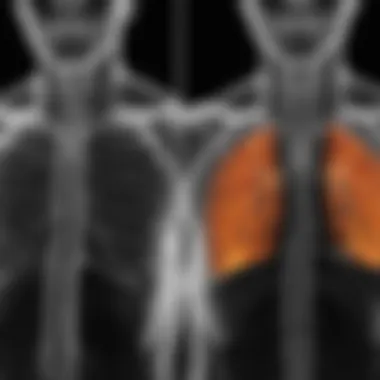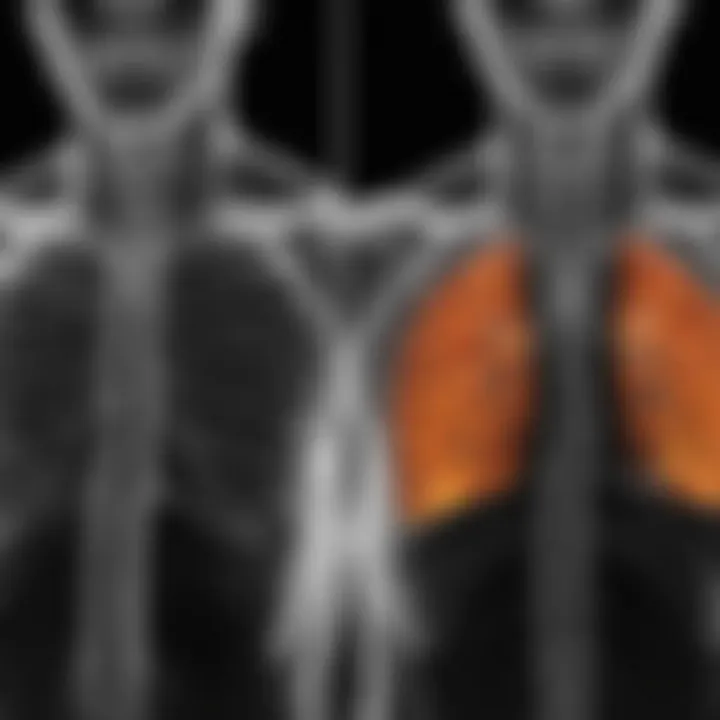Understanding COPD and Chest X-rays in Diagnosis


Intro
Chronic obstructive pulmonary disease (COPD) significantly impacts the lives of millions globally. It encompasses a range of respiratory conditions that cause airflow limitation, leading to symptoms such as chronic cough, breathlessness, and frequent respiratory infections. Diagnosing COPD can be challenging, as it often requires a combination of clinical assessments, patient history, and imaging techniques. One of the key imaging methods utilized in this process is the chest X-ray. This article aims to explore the critical role of chest X-rays in diagnosing and managing COPD, examining their advantages, limitations, and the specific indicators medical professionals should consider during radiological evaluations.
Key Findings
Major Results
Chest X-rays serve multiple functions in the diagnosis of COPD. Primarily, they can help identify structural changes in the lungs and rule out other potential conditions that could mimic COPD symptoms. In patients with COPD, findings such as hyperinflation, flattened diaphragm, and increased retrosternal airspace can indicate disease progression.
Some studies have demonstrated that while chest X-rays are not definitive diagnostic tools for COPD, they can support clinical judgment and facilitate better management strategies. Research indicates that timely recognition of COPD using radiographic means can significantly influence patient outcomes. Moreover, chest X-rays can be crucial in monitoring disease progression and treatment efficacy.
Discussion of Findings
The role of chest X-rays in COPD diagnosis prompts a nuanced understanding. While these imaging techniques are useful, they cannot replace pulmonary function tests, which remain the gold standard for diagnosing COPD. However, X-rays provide valuable supplementary information, especially in cases where lung pathology must be evaluated in conjunction with clinical findings.
It is essential for healthcare providers to recognize the limitations of chest X-rays. For example, mild cases of COPD may not show significant X-ray changes, leading to potential missed diagnoses. Additionally, the interpretation of X-ray results requires expertise to distinguish between normal variations and pathological changes. As such, training and familiarity with X-ray findings are paramount for effective assessment.
Methodology
Research Design
The exploration of the role of chest X-rays in COPD diagnosis involves a comprehensive review of both existing literature and current clinical practices. A qualitative participatory design allows for a detailed understanding of how chest X-rays are integrated into clinical pathways for diagnosing COPD. This integration is assessed in terms of various imaging findings, their implications for patient management, and the interplay between X-ray results and other diagnostic modalities.
Data Collection Methods
Data is sourced from peer-reviewed journals, clinical guidelines, and expert opinions to ensure a robust analysis. Key databases such as PubMed and Google Scholar are utilized to gather relevant studies focused on the diagnostic processes involved in COPD assessment. This method ensures that recent and relevant information informs our exploration of chest X-rays in COPD.
By synthesizing these findings, this article offers a comprehensive guide to understanding the integration of chest imaging in COPD management and highlights the importance of accurate X-ray interpretation.
Prologue to Chronic Obstructive Pulmonary Disease
Chronic Obstructive Pulmonary Disease, commonly known as COPD, represents a significant health concern worldwide. The nature of this disease necessitates an understanding of its various facets for effective diagnosis and management. As healthcare professionals increasingly encounter COPD patients, it becomes essential to grasp the clinical implications tied to its identification and treatment.
COPD encompasses a group of progressive respiratory disorders that impede airflow, resulting in breathing difficulties. Recognizing the complexity of the disease is crucial for medical practitioners, as it presents an array of symptoms that affect a patient’s quality of life. The prevalence of COPD underlines the need for healthcare systems to adapt and innovate ways to manage this chronic condition.
Understanding COPD leads to early intervention and more personalized treatment plans. The focus of this article is to dissect the role of chest X-rays as a pivotal tool in diagnosing COPD. Chest X-rays serve not only in confirming the diagnosis but also in monitoring disease progression and evaluating complications that may arise. The interplay between clinical assessment and radiological imaging provides a comprehensive approach to COPD management.
Insights into the different stages and presentations of COPD will be discussed. With this knowledge, healthcare providers can better navigate the complexities of patient care. Additionally, highlighting the importance of imaging techniques, particularly chest X-rays, aims to enhance the overall understanding of COPD among medical professionals.
Ultimately, this article encourages a re-evaluation of traditional diagnostic methods, shedding light on how integrating imaging into patient evaluation can lead to enhanced outcomes in care and management of COPD.
Clinical Presentation of COPD
The clinical presentation of Chronic Obstructive Pulmonary Disease (COPD) is crucial in understanding how the disease affects patients and how it can be diagnosed effectively. Well-recognizing the symptoms and stages aids in formulating effective treatment plans and managing patient expectations. This understanding is essential for healthcare professionals, including students and researchers, as it helps identify signs of progression and significance in the patient’s quality of life.
Symptoms and Signs
COPD is characterized by a variety of symptoms that can range from mild to severe. The most common symptoms include:
- Chronic Cough: A persistent cough, often with sputum production, that lasts for several months.
- Dyspnea: Shortness of breath that typically worsens with exertion.
- Wheezing: A whistling sound during breathing, indicating airway obstruction.
- Chest Tightness: A feeling of pressure or constriction in the chest area.
These symptoms may develop gradually, often leading patients to dismiss them as normal effects of aging or lifestyle. It is critcial to note that early diagnosis improves prognosis, making awareness of these symptoms vital. The presence and severity of these signs can indicate how far the disease has progressed, allowing healthcare providers to adjust treatment strategies accordingly.
"Understanding and identifying symptoms can lead to earlier interventions and better outcomes for patients."


Stages of COPD
COPD is classified into different stages based on the severity of the disease and its impact on lung function. The Global Initiative for Chronic Obstructive Lung Disease (GOLD) provides a framework to determine the stages of COPD:
- Mild (GOLD 1): FEV1 (Forced Expiratory Volume in one second) is 80% or more of predicted. Symptoms may be absent or mild.
- Moderate (GOLD 2): FEV1 is between 50% and 79% of predicted. Symptoms become noticeable and may impact daily life.
- Severe (GOLD 3): FEV1 is between 30% and 49% of predicted. Increased breathlessness and fatigue present.
- Very Severe (GOLD 4): FEV1 is less than 30% of predicted. Life-threatening respiratory failure may occur, and quality of life is significantly affected.
Each stage indicates not just the decline in lung function but also the necessity for a tailored management approach. Healthcare professionals must recognize these stages to offer appropriate therapeutic interventions, lifestyle modifications, and support. Early identification and management can prevent complications and maintain patient independence.
Diagnostic Approach to COPD
The diagnostic approach to chronic obstructive pulmonary disease (COPD) is fundamental in establishing an accurate diagnosis and appropriate management plan. Early detection of COPD can significantly improve patient outcomes. A structured diagnostic process typically involves evaluating the patient’s history, physical examination, and a series of tests. These tests help differentiate COPD from other respiratory conditions and assess the severity of the disease.
Spirometry and Lung Function Tests
Spirometry is a cornerstone in the assessment of COPD. This test measures the amount of air a person can forcibly exhale in one second, known as the forced expiratory volume in one second (FEV1). A reduced FEV1 in relation to the forced vital capacity (FVC) indicates airflow limitation, which is indicative of COPD.
Key points about spirometry include:
- Diagnosis: A post-bronchodilator FEV1/FVC ratio of less than 0.70 confirms the presence of airflow limitation.
- Severity classification: Based on FEV1 results, COPD can be classified into mild, moderate, severe, and very severe stages.
- Monitoring: Regular spirometry tests help monitor disease progression and response to therapy.
Lung function tests may also include assessments such as total lung capacity and diffusion capacity. These tests provide additional information about the lung's ability to exchange gases, further detailing the impact of COPD on a patient’s respiratory status.
The Role of Imaging in Diagnosis
Imaging plays a critical role in the comprehensive evaluation of COPD. Although spirometry is essential for diagnosis, chest X-rays and other imaging techniques can provide valuable insights into the structural changes within the lungs.
Chest X-rays can help:
- Confirm diagnosis: While not definitive, X-rays can reveal hyperinflation and flattened diaphragm, which are common in COPD.
- Rule out other conditions: Imaging can help identify intersecting diseases, such as pneumonia or lung cancer, particularly in smokers.
- Assess comorbidities: Conditions like heart failure can mimic or exacerbate COPD symptoms, so imaging aids in holistic patient assessment.
Thus, while spirometry provides the functional assessment, imaging complements it by addressing anatomical and pathological considerations, ensuring that a comprehensive strategy is adopted for the effective management of COPD.
In summary, an effective diagnostic approach involving spirometry and imaging is essential in the management of COPD. It allows for early intervention and tailored treatment options, which ultimately leads to improved patient outcomes.
By thoroughly understanding the diagnostic landscape of COPD, healthcare professionals can better navigate the complexities of this disease.
Chest X-ray: An Overview
Chest X-rays play a crucial role in the diagnosis and management of Chronic Obstructive Pulmonary Disease (COPD). They provide essential visual information about the lung structure and can reveal various pathological changes associated with this disease. Despite the existence of more advanced imaging modalities, chest X-rays remain a fundamental tool due to their accessibility and speed.
The benefits of chest X-rays in the clinical setting are notable. They assist in confirming the diagnosis of COPD by visualizing hyperinflation, flattened diaphragm, and potential lung damage, which are characteristic features of the disease. Furthermore, these X-rays can help identify comorbid conditions and other pulmonary diseases that may coexist with COPD.
However, chest X-rays do have some limitations. They may not depict early changes in lung pathology or subtle abnormalities. In some cases, findings can be ambiguous, making it challenging to differentiate COPD from other conditions. Awareness of these aspects is vital for healthcare providers to make informed diagnostic decisions.
Understanding the role of chest X-rays thus serves as a bridge between basic radiologic training and practical decision-making in the context of COPD management.
What is a Chest X-ray?
A chest X-ray is a radiographic image of the chest area, which includes the lungs, heart, and surrounding structures. It uses a small amount of radiation to create images that help clinicians assess the condition of the thoracic cavity. The X-ray film captures the density of different tissues. Air in the lungs appears black, while bones and other dense structures, such as the heart, show up as white. This contrast allows for the detailed visualization of lung structures and potential abnormalities.
Understanding what a chest X-ray can reveal is critical for effective diagnosis. For instance, in COPD, the X-ray can show signs of lung overinflation, as well as changes in lung shape, which indicate chronic damage.
Indications for Chest X-rays in COPD
Chest X-rays are indicated in various scenarios when evaluating patients with suspected or diagnosed COPD:
- Initial Assessment: When a patient presents with respiratory symptoms, a chest X-ray is often performed to assess lung health.
- Monitoring Disease Progression: Regular X-rays help providers track the development of COPD or the emergence of complications.
- Evaluating Exacerbations: In cases of acute exacerbation, a chest X-ray can help identify infections or other acute changes requiring immediate intervention.
- Differentiating Conditions: Chest X-rays can help distinguish COPD from other pulmonary diseases such as pneumonia or lung cancer by revealing distinct radiographic patterns.


Key Note: While chest X-rays are valuable, clinicians should not rely on them solely for diagnosing COPD. They should be integrated with clinical assessment and other diagnostic tools for comprehensive evaluation.
Interpreting Chest X-rays in COPD
Interpreting chest X-rays in Chronic Obstructive Pulmonary Disease (COPD) is vital for understanding the condition's severity and progression. The chest X-ray serves as a key tool in the diagnostic process, helping to visualize lung structure and detect anomalies. Proper interpretation of these images can thus significantly aid in patient management and treatment decisions.
The benefits of using chest X-rays in COPD include their ability to provide immediate visual data about lung condition. This allows for quick assessments regarding the presence of emphysema or other associated conditions. Clinicians can identify characteristic features that may indicate worsening status. However, interpretation requires experience and an understanding of what is normal versus abnormal in the context of COPD.
Several elements factor into the accurate interpretation of chest X-rays. The radiologist must consider the patient’s clinical history, the stage of COPD, any comorbidities, and the specific symptoms the patient is exhibiting. A thorough assessment helps in forming a more holistic understanding of the patient's health.
Common Radiologic Features of COPD
When reviewing chest X-rays for COPD, certain features consistently appear that can assist clinicians in making informed diagnoses. These features include:
- Hyperinflation: This is indicated by an increased thoracic volume, a flattening of the diaphragm, and a more horizontal orientation of the ribs, which suggests air trapping in the lungs.
- Bullae Formation: These appear as large, dark spaces within the lung fields, indicating areas where lung tissue has been distended and weakened. They reflect destruction typical of emphysema.
- Increased Lung Markings: When the blood vessels and connective tissue become more prominent, often due to the effects of chronic inflammation, this may indicate bronchitis.
- Cardiac Silhouette Changes: In some cases, the heart can be affected, showing signs of being more pronounced or altered due to the challenges presented by COPD.
These features provide critical clues for the diagnosis and treatment pathways and help in monitoring disease progression.
Differentiating COPD from Other Conditions
Differentiating COPD from similar respiratory conditions is crucial for effective management. Chest X-rays can reveal distinctive signs that help distinguish COPD from other diseases. Key considerations include:
- Asthma vs. COPD: Asthma may demonstrate more variable airflow obstruction and typically does not show signs such as hyperinflation. In contrast, COPD tends to display consistent airflow limitations.
- Interstitial Lung Disease: This condition often results in a reticular pattern on the X-ray, while COPD usually shows more emphysematous changes.
- Lung Cancer: Tumors may present as discrete masses or nodules, which need closer examination alongside existing COPD features to avoid misdiagnosis.
Ultimately, a radiological expert's interpretation plays a significant role in guiding treatment modalities. Therefore, physicians should maintain a strong familiarity with the nuances in radiologic features of these varied conditions.
Advantages of Chest X-rays in COPD Management
Chest X-rays play a vital role in the management of Chronic Obstructive Pulmonary Disease (COPD). Their significance lies in several aspects that enhance the diagnosis, monitoring, and treatment of this condition. Understanding these advantages helps in optimizing patient care and ensuring timely interventions.
Accessibility and Cost-effectiveness
Accessibility is one of the key strengths of Chest X-rays. Many healthcare facilities have the necessary equipment for X-ray imaging, often allowing for quicker access compared to other imaging modalities such as CT scans or MRIs. This feature makes Chest X-rays an ideal choice, especially in emergency or resource-limited settings.
Moreover, the cost associated with Chest X-ray procedures is substantially lower than that of more advanced imaging techniques. Patients often find it easier to afford X-rays, and insurance coverage is typically more comprehensive. This financial aspect enhances compliance with diagnostic protocols, enabling better screening for COPD in diverse populations.
In summary, the combination of accessibility and cost-effectiveness ensures that Chest X-rays remain a primary imaging tool in the evaluation and ongoing management of COPD, thereby guiding clinicians in making informed decisions rapidly.
Speed of Diagnosis
The urgency in diagnosing COPD cannot be overstated. Chest X-rays provide immediate insights into the pulmonary condition. With rapid image acquisition and processing, healthcare providers can quickly assess the lung architecture, identifying critical changes that may indicate COPD exacerbations or complications.
In clinical practice, the speed of diagnosis afforded by Chest X-rays allows for timely interventions. For patients presenting with respiratory distress, X-rays can facilitate the detection of issues such as hyperinflation, flattened diaphragms, or other anatomical alterations that are characteristic of COPD. This expeditious approach can be essential in acute care settings, where every moment counts in patient management and treatment initiation.
Thus, the prompt nature of Chest X-ray results adds significant value in managing COPD, streamlining the pathway from diagnosis to appropriate clinical action.
Limitations of Chest X-rays in COPD
Chest X-rays play a significant role in the diagnostic landscape of COPD. However, it is essential to understand that they come with limitations that can affect their reliability and effectiveness in clinical settings. Recognizing these limitations is crucial for healthcare professionals, as it influences decision-making and subsequent patient management strategies. Among the most prominent concerns are the overlapping radiographic features with other pulmonary conditions and the challenges in detecting early changes in disease progression.
Radiographic Overlap with Other Diseases
Chest X-rays often reveal findings that are not unique to COPD. For instance, conditions like asthma, bronchiectasis, and pulmonary fibrosis can exhibit similar radiographic signatures. The presence of hyperinflation, flattened diaphragms, or increased retrosternal airspace is not exclusive to COPD. When such findings appear on an X-ray, there is a risk of misinterpretation, leading to potential misdiagnosis.
Furthermore, this overlap necessitates a thorough clinical correlation. In some cases, a chest X-ray might show signs that can confuse healthcare providers, delaying appropriate treatment.
- Misleading signs can result in:


- Inaccurate diagnosis
- Incorrect treatment plans
- Increased healthcare costs
Overall, while chest X-rays may help in identifying the presence of a respiratory condition, their nonspecific findings should be interpreted cautiously.
Inability to Detect Early Changes
Another inherent limitation of chest X-rays in the context of COPD is their inability to detect early pathological changes in lung tissue. COPD often begins with subtle airway inflammation and damage that may not manifest significantly on an X-ray until the disease has progressed substantially. This can lead to a false sense of reassurance among clinicians and patients alike.
The sensitivity of X-rays for early COPD changes is limited compared to more advanced imaging modalities. As a result, if clinicians rely solely on chest X-rays, they might miss critical early indicators of disease progression. Regular surveillance that includes functional assessments, such as spirometry, remains essential alongside imaging.
Key point: Early intervention is crucial for effective COPD management. Failure to detect early changes may adversely impact patient outcomes.
Comparison with Other Imaging Modalities
In the landscape of respiratory diagnostics, chest X-rays offer a distinct method for assessing conditions like chronic obstructive pulmonary disease (COPD). However, their limitations necessitate an integrated approach involving other imaging modalities. This section elucidates why comparing these various imaging techniques is essential. The differences in resolution, sensitivity, and the capacity to reveal specific anatomical and functional details make it crucial for healthcare professionals to discern when to use chest X-rays, CT scans, MRI, or nuclear imaging in the diagnosis and management of COPD.
CT Imaging in COPD Diagnosis
Computed tomography (CT) imaging is widely recognized for its superior ability to provide detailed cross-sectional images of the lungs. Its significance in COPD diagnosis cannot be overstated. One prominent advantage of CT is its ability to detect emphysema, one of the hallmark features of COPD. Unlike chest X-rays, which often provide limited visual information, a CT scan can identify the extent of emphysematous changes and bronchial wall thickening with great precision.
"CT scans offer a three-dimensional perspective that reveals lung morphology, which is critical for accurate diagnosis and management of COPD."
Criteria such as lobar involvement and the degree of air trapping are more easily evaluated with CT. Additionally, CT angiography can assist in ruling out pulmonary embolisms that may complicate the clinical picture of a COPD patient. Despite these benefits, the trade-off includes higher exposure to radiation and increased costs. Thus, while CT imaging presents comprehensive data, healthcare practitioners must carefully weigh these factors.
MRI and Nuclear Imaging Applications
Magnetic resonance imaging (MRI) is less commonly utilized in COPD, yet it provides unique advantages. Its ability to assess soft tissue structures without ionizing radiation is a noteworthy benefit. For conditions like bronchiectasis associated with COPD, MRI can be instrumental in understanding underlying pathophysiology. However, the logistical challenges and longer acquisition times limit its general application for all COPD patients compared to chest X-rays and CT scans.
Nuclear imaging, encompassing techniques like positron emission tomography (PET), has a unique role in assessing pulmonary diseases. For COPD, it allows for functional imaging of lung tissues, which can reveal inflammation status and perfusion levels. This capability can be valuable, especially in advanced stages or for patients with unclear diagnoses. Again, while nuclear imaging provides detailed insights, its cost and accessibility may hinder practical use in everyday clinical settings.
Future Directions in COPD Imaging
The landscape of diagnosing and managing chronic obstructive pulmonary disease (COPD) is continuously evolving. This section emphasizes the future directions in COPD imaging. Advances in technology and the integration of artificial intelligence (AI) hold the promise to transform how healthcare professionals approach this challenging disease. These developments will not only improve diagnostic accuracy but also enhance the overall management of COPD.
Advancements in Radiologic Technology
Recent advancements in radiologic technology have paved the way for more precise imaging. Techniques like 3D imaging and high-resolution computed tomography (HRCT) provide detailed views of lung anatomy. This level of detail aids in identifying subtle changes in lung structure that traditional chest X-rays might miss.
- Low-Dose CT: This method reduces radiation exposure while maintaining image quality. It enables the early detection of COPD before significant symptoms manifest.
- Portable Imaging Equipment: New technology allows for imaging in various settings, including outpatient clinics and even patients' homes, improving accessibility to vital radiological evaluations.
These improvements suggest a shift toward personalized medicine, allowing tailored treatment plans based on individual imaging profiles.
Integrating AI in Imaging Diagnoses
Artificial intelligence is set to redefine the paradigm of imaging in COPD diagnosis. AI algorithms can analyze imaging data with remarkable speed and accuracy. These systems learn from vast datasets, becoming adept at recognizing patterns that even experienced radiologists might overlook.
- Automated Image Analysis: AI can facilitate quicker readings of chest X-rays and CT scans, helping radiologists prioritize cases that require immediate attention.
- Predictive Analytics: AI tools can evaluate past imaging results and clinical data to predict disease progression or exacerbations. This foresight allows for timely interventions, potentially improving patient outcomes.
Integrating AI into the imaging diagnostics framework not only fosters efficiency but also elevates the quality of care provided.
Ending
The conclusion of this article serves as a vital component in understanding the implications of chest X-rays in diagnosing and managing chronic obstructive pulmonary disease (COPD). It recaps essential insights while reinforcing the significance of radiographic imaging in clinical practice.
Summary of Key Points
In reviewing the major points discussed throughout the article, it is clear that chest X-rays provide critical visual assessments that aid healthcare professionals in recognizing and evaluating COPD. Radiographic findings, such as hyperinflation and other characteristic signs, can support the diagnosis along with clinical evaluations.
Through integration of chest X-rays in the diagnostic process, practitioners can enhance their ability to differentiate COPD from other respiratory disorders. However, a nuanced understanding of the benefits and limitations of X-rays is essential in ensuring optimal patient care.
The Future of COPD Diagnosis
As technology advances, the future of COPD diagnosis looks promising. Innovations in imaging techniques are continuously evolving, offering the potential for higher accuracy and efficiency in diagnosing this disease. Chest X-rays remain an essential tool, but as researchers explore new imaging modalities, their role may expand or adapt to complement other advanced imaging options.
Moreover, integrating artificial intelligence (AI) into diagnostic procedures can potentially refine the evaluation of chest X-ray images, allowing for improved detection of COPD-related changes. The initiative to adopt AI in imaging may reshape the landscape of pulmonary diagnostics, making diagnosis more precise and timely.
In summary, while chest X-rays continue to offer valuable insights into COPD, ongoing research and technological developments hold the key to overcoming current limitations and enhancing diagnostic capabilities.



